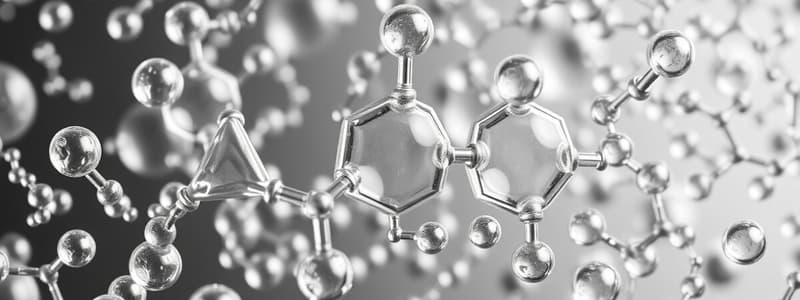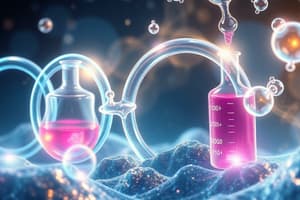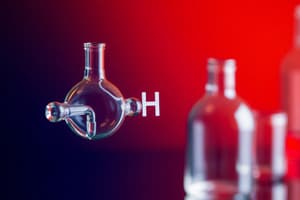Podcast
Questions and Answers
What is the general molecular formula for alkanes?
What is the general molecular formula for alkanes?
- CnH2n+2 (correct)
- CnH2n-2
- CnH2n
- C2nH2n+2
Which of the following is true about the reactivity of alkanes?
Which of the following is true about the reactivity of alkanes?
- Alkanes react spontaneously with metal ions.
- Alkanes are highly reactive and readily participate in many reactions.
- Alkanes are relatively unreactive under normal conditions. (correct)
- Alkanes only react with acids.
How are the names of alkyl groups derived?
How are the names of alkyl groups derived?
- By replacing the -ane ending of the corresponding alkane with -yl. (correct)
- By adding a prefix to the alkane name.
- From the names of functional groups.
- From the names of cycloalkanes.
What characteristic of alkanes contributes to their low density?
What characteristic of alkanes contributes to their low density?
What happens to the boiling and melting points of alkanes as the number of carbon atoms increases?
What happens to the boiling and melting points of alkanes as the number of carbon atoms increases?
What is the general molecular formula for cycloalkanes?
What is the general molecular formula for cycloalkanes?
Which of the following best describes the solubility of alkanes in water?
Which of the following best describes the solubility of alkanes in water?
When naming a chain of alkanes, which rule is used for organizing substituent groups?
When naming a chain of alkanes, which rule is used for organizing substituent groups?
What does a skeletal/line formula assume about the arrangement of carbon atoms?
What does a skeletal/line formula assume about the arrangement of carbon atoms?
Which type of formula shows all atoms in a molecule sequentially bonded?
Which type of formula shows all atoms in a molecule sequentially bonded?
Which organization is responsible for establishing rules for IUPAC nomenclature?
Which organization is responsible for establishing rules for IUPAC nomenclature?
What is represented by the lines in a structural formula?
What is represented by the lines in a structural formula?
Which statement accurately describes functional groups in organic molecules?
Which statement accurately describes functional groups in organic molecules?
Which type of carbon is directly bonded to one other carbon atom?
Which type of carbon is directly bonded to one other carbon atom?
Which of the following statements is true about double bonds in carbon compounds?
Which of the following statements is true about double bonds in carbon compounds?
What is the characteristic of organic substances regarding their melting points?
What is the characteristic of organic substances regarding their melting points?
Which type of bond involves sharing three pairs of electrons?
Which type of bond involves sharing three pairs of electrons?
How is a molecular formula defined?
How is a molecular formula defined?
Which characteristic is NOT typically associated with organic substances?
Which characteristic is NOT typically associated with organic substances?
What is the role of nomenclature in organic chemistry?
What is the role of nomenclature in organic chemistry?
Which type of carbon atom is bonded to four other carbon atoms?
Which type of carbon atom is bonded to four other carbon atoms?
Flashcards are hidden until you start studying
Study Notes
Alkanes
- Alkanes have the general formula CnH2n+2, where n represents the number of carbon atoms.
- Only contain single bonds, classifying them as saturated hydrocarbons.
- Naming involves identifying and naming groups attached to the carbon chain.
Naming Alkanes
- Chain numbering starts from the end closest to a substituent group.
- Each substituent group's location is designated by a number and name.
- Assemble the name by listing groups in alphabetical order; prefixes like di, tri, or tetra are ignored in this alphabetical arrangement.
Properties of Alkanes
- Alkanes are colorless hydrocarbons and less dense than water.
- These molecules are non-polar and insoluble in water.
- Short-chain alkanes have low melting and boiling points, which increase with longer carbon chains.
- Generally unreactive, alkanes combust with oxygen, emitting energy that is useful in fuels.
- React with halogens such as chlorine and bromine.
Alkyl Groups
- Formed from alkanes by removing one hydrogen atom.
- Alkyl group names derive from the alkane and replace the -ane ending with -yl.
Cycloalkanes
- Structurally consist of carbon atoms connected by C-C single bonds in a ring formation.
- Follow the general molecular formula CnH2n, resulting in two less hydrogen atoms than alkanes.
Types of Bonds
- Single Bond: Formed by sharing one pair of electrons (2 electrons).
- Double Bond: Involves sharing two pairs of electrons between carbon atoms.
- Triple Bond: Involves sharing three pairs of electrons between carbon atoms.
Importance of Carbon
- Carbon is the central element in organic compounds essential for life.
- Its absence would mean the non-existence of life on Earth.
- Carbon’s versatility enables the formation of a variety of compounds.
Classification of Carbon
- Primary Carbon: Bonded to one other carbon atom.
- Secondary Carbon (2°): Bonded to two other carbon atoms.
- Tertiary Carbon (3°): Bonded to three other carbon atoms.
- Quaternary Carbon (4°): Bonded to four other carbon atoms.
Properties of Organic Substances
- Typically low melting and boiling points.
- Low solubility in water; high solubility in nonpolar solvents.
- Flammable in nature.
- Aqueous solutions do not conduct electricity.
- Exhibit covalent bonding.
Types of Chemical Formulas
- Molecular Formula: Indicates the type and number of atoms without showing bonding structure.
- Structural Formula: Shows the arrangement of atoms and the location of chemical bonds, using lines to represent bonds.
- Condensed Formula: Organizes atoms in a sequence to show bonding relationships clearly.
- Skeletal/Line Formula: Simplified representation where carbon atoms are implied at line intersections and ends; assumes hydrogen is bonded as needed.
Nomenclature
- Common Names: Not bound by strict naming rules.
- IUPAC Nomenclature: Follows internationally accepted rules for naming organic compounds, allowing one to deduce structure from the name.
- The International Union of Pure and Applied Chemists sets and maintains naming standards for organic compounds.
Functional Groups
- Atoms or groups of atoms responsible for the chemical and physical properties of a molecule, crucial in defining the behavior of organic compounds.
Studying That Suits You
Use AI to generate personalized quizzes and flashcards to suit your learning preferences.




